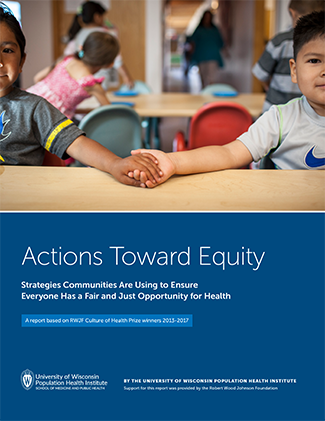Actions Toward Equity, a new report from the University of Wisconsin Population Health Institute, shares lessons learned from the 2013-2017 Prize winning communities. This report can be a helpful resource for communities striving to give all residents a fair and just opportunity for health.
 Since 2013, the Robert Wood Johnson Foundation Culture of Health Prize has honored communities across the country working at the forefront of advancing health, opportunity, and equity for all. Representing diverse places—cities, counties, tribes, regions, and small towns; urban, rural, and suburban—Prize winners are tackling social and economic challenges that impact how long and how well we live.
Since 2013, the Robert Wood Johnson Foundation Culture of Health Prize has honored communities across the country working at the forefront of advancing health, opportunity, and equity for all. Representing diverse places—cities, counties, tribes, regions, and small towns; urban, rural, and suburban—Prize winners are tackling social and economic challenges that impact how long and how well we live.
Prize winners represent diverse communities – cities, counties, tribes, regions, and small towns; rural, urban, and suburban places – that face myriad physical, economic, and demographic challenges. For example, more than three-quarters of Prize winners have higher rates of children living in poverty than the national 2016 rate of 20%; children in poverty rates capture an upstream measure of poverty that assesses both current and future health risk. These rates underscore the importance of strategies that improve social and economic factors, maximize existing assets, build partnerships, and engage residents to improve health for everyone.
All Prize-winning communities are working to advance equity in multiple ways across the six Prize criteria (see box below). This analysis of Prize winners’ application materials, conducted by the University of Wisconsin Population Health Institute, specifically examines two areas considered crucial to advancing health and equity where Prize winners stand out:
1. What strategies are Prize-winning communities using to address social and economic conditions that influence health and equity?
2. How are leaders, partners, and residents working together to improve community health and equity?
To answer these questions, community strategies (i.e., policies and programs to improve community health and equity) were identified from Prize-winning application materials and categorized according to areas in the County Health Rankings model and strategies in What Works for Health, a database of evidence-informed policies and programs.
Next, application materials were qualitatively analyzed for themes and examples of how leaders, partners, and residents are working together – especially in ways that engage residents from historically excluded groups in shaping priorities, decisions and solutions – and building advocacy and leadership capacity.
This report summarizes promising approaches and highlights concrete examples that Prize-winning communities have employed in these areas, which may offer useful insights to others striving to advance equity and reduce disparities.